Selecting the perfect pot for your cherished plants is more than just an aesthetic choice. The material of your planter significantly impacts plant health, longevity, and overall garden aesthetics. From the classic terracotta and ceramic, to modern fibreglass planters each material offers unique advantages and considerations.
Understanding these differences is crucial in creating a thriving and visually appealing outdoor space. The pots and planters you select for your garden depend on where they will be used, whether they will be exposed to the elements, and if they will need to be moved frequently. Design considerations such as colour, texture, and theme are also important.
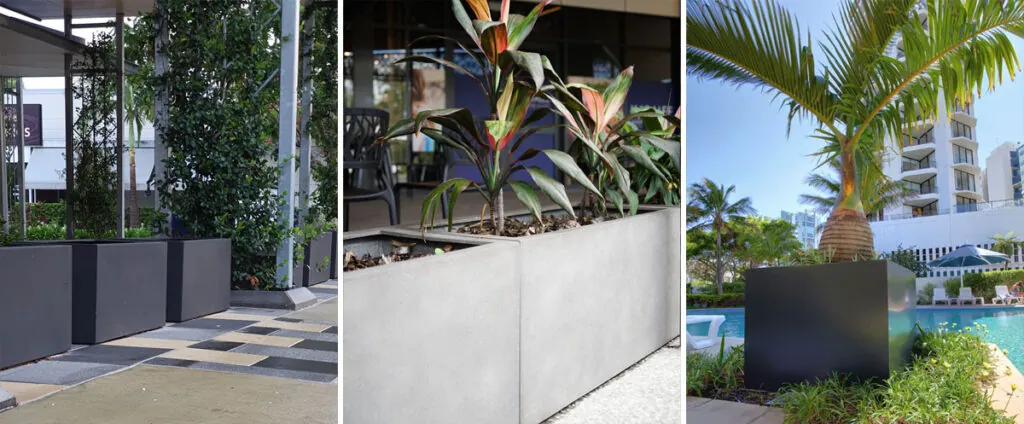
According to BBC ‘Gardener of the Decade’, Katherine Crouch, “a good pot is a good investment.” So, choose quality pots that complement your theme.
Different Types of Planter Materials
Update. I first wrote this guide and created the video below almost 10 years ago when we stocked a wide variety of planter materials. Through trial and (mostly) error, I’ve come to understand that heavy-duty fibreglass and GRC are vastly superior to all other materials for planters. For this reason, we now only stock fibreglass and GRC. We no longer carry stone, terrazzo, glazed, or terracotta planters. While these materials are still available on the market, you won’t find them from us.
Watch the video below as we review:
- Terrazzo
- Stone: Granite and Slate
- Lightweight: Fibreglass and Glass Reinforced Concrete (GRC)
- Glazed
- Terracotta
Lightweight Planters
Lightweight planters offer a transformative approach to horticultural and landscape design, redefining possibilities for both professionals and enthusiasts alike.
Agile and Adaptable: Their reduced weight empowers effortless handling, transportation, and installation, significantly boosting operational efficiency and reducing labor demands. This flexibility unlocks dynamic and ever-evolving outdoor spaces, allowing for spontaneous reconfigurations to match changing seasons, trends, or events.
Resilient and Refined: Modern manufacturing techniques have produced lightweight planters that defy expectations, combining exceptional strength with minimal weight. These planters stand as resilient guardians against the elements, weathering temperature extremes, harmful UV rays, and frosty conditions with grace. Their aesthetic versatility seamlessly integrates into diverse design styles, from classic elegance to avant-garde modernity. Moreover, their lightweight nature liberates creative expression, enabling breathtaking suspended installations and elevated displays that captivate the eye.
Eco-Conscious Elegance: Beyond their functional and aesthetic benefits, lightweight planters contribute to a greener future. Reduced transportation weight translates to lower fuel consumption and carbon emissions, making them an eco-conscious choice.
Types of Lightweight Planters:
Fiberglass Planters
The technology available today places Fibreglass Planters at the top of their class. Crafted through a meticulous process involving the reinforcement of a polymer matrix, fibreglass planters exhibit exceptional strength and flexibility. This advanced manufacturing technique enables the creation of planters resistant to cracking and breakage, ensuring lasting beauty and performance in the face of nature’s elements.
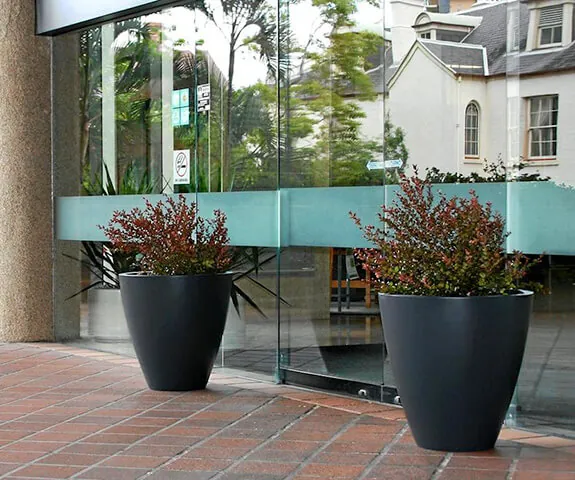
Lightweight Concrete Planters
Glass Reinforced Concrete (GRC) is a composite material combining cement, water, fine aggregates, chemical admixtures, and alkali-resistant glass fibres. These fibres are dispersed within the concrete matrix, significantly enhancing its strength, flexibility, and durability.
While GRC offers a high strength-to-weight ratio compared to many materials, it remains at least twice as heavy as fibreglass. Additionally, GRC lacks the tensile strength and flexibility of fibreglass, making it more prone to cracking and chipping. For these reasons, we recommend GRC primarily for applications where weight is a significant factor, such as public spaces.
In most cases, a fibreglass planter with a cement or rendered veneer is a more suitable choice.
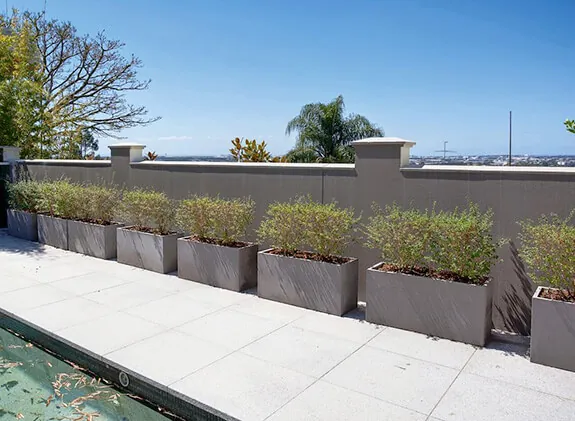
Stone Planters
These planters are made of natural stone, which tend to be very expensive and heavy. But, they have a natural beauty, giving them a load of character.
Unlike wood or plastic, stone planters are strong and durable. They won’t rot or become brittle over time. Because they’re made of heavy material, they’re less likely to blow over in the wind or get knocked down by children or pets.
Many stone planters come in large sizes. These are strong enough that large roots won’t break the pot. The thickness of these planters also help protect the soil from temperature fluctuations.
Types of Stone Planters:
Granite Planters
Tough, strong, and durable. Granite Planters are the densest and most impact-resistant of all. They’re ideal for displays and planting areas in public environments. Even if you leave them in areas with a lot of traffic, nobody will be able to take them.
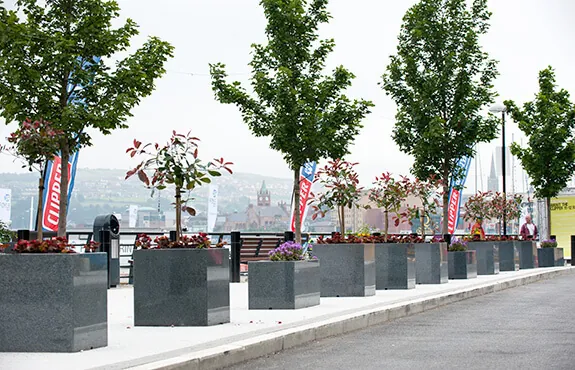
Slate Planters
The beautiful natural stone of slate planters is the finishing touch to any landscape environment. They’re durable and heavy, so they can withstand wear and tear of commercial use.
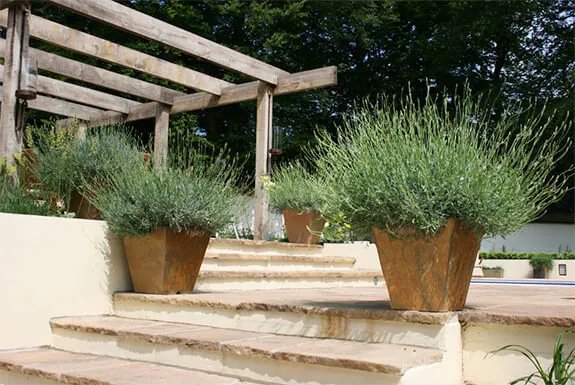
Slate is a natural stone made of sedimentary layers, the soft colours of the slate planters make them fun to plant and design with, as they match a wide palette of plants.
Terrazzo Planters
Terrazzo is a physically strong material that stands up to heavy use. However, weather conditions may cause them to fade and dry, so don’t leave them outside unprotected. Sealers are often used to prevent stains and fading.
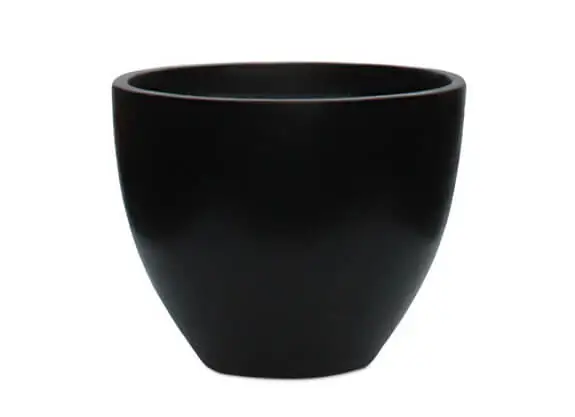
Consisting of a variety of materials, most terrazzo pots are now polished and sealed to create a smooth finish. They usually come in a black or white finish, which goes with all colour schemes.
Ash Lennon of M. Lennon Pots and Planters, one of the leading suppliers of export-quality garden pots, has this to share:
Terrazzo, which is basically concrete with pebble ground back to leave a speckled finish is in fashion. It’s everywhere – bench tops, pavers it’s a clean cut gloss look everyone likes. They have straight edges, straight lines. They match so much with the contemporary style of housing these days.
Glazed Planters
Glazed pots are available in a wide variety of colours, patterns and sizes. Because of their low porosity, these planters have excellent water retention. It can also provide good insulation for the protection of root systems.
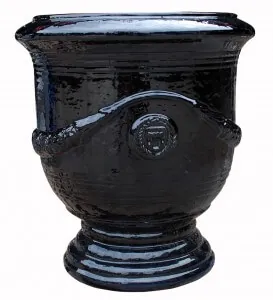
For Ash Lennon, glazed pots will make any garden sparkle. More so, the colours and patterns for these containers are limitless – blue, green, black, white, cream and reds.
He also adds…
To make a glaze pot we mix water and powdery chemical together, tip in on an uncooked pot and cook in a kiln to 1200 degrees. In the kiln, the chemicals react to leave a bright shiny glaze embedded into the clay.
Our Recommendation
Fibreglass planters offer a superior alternative to traditional planter materials, such as glazed, terracotta, terrazzo, concrete or even more modern light-weight materials such fibre-clay, fibre-stone, or GRC. Engineered with exceptional strength and durability, these planters are ideal for a wide range of applications in commercial and residential landscapes.
Unmatched Strength and Durability
Unlike GRC and fibrestone, which are prone to cracking and breakage, fibreglass possesses inherent flexibility and impact resistance. The reinforced polymer matrix creates a robust structure capable of withstanding harsh weather conditions, including frost, heat, and UV exposure. This durability translates into long-term cost savings as fibreglass planters require minimal maintenance and replacement. That’s why we can back these with a 3-Year-Warranty you will not find from other planter suppliers.
What is Different About Our Fibreglass Planters?
IOTA’s fibreglass planters are the result of a meticulous manufacturing process that combines advanced technology with traditional craftsmanship. To meet the diverse needs of our clients, we operate two modern factories in China and Vietnam, each employing distinct production techniques.
Our Chinese facility specialises in the sheet moulding compound (SMC) process. This method involves compressing layers of resin-impregnated fibreglass sheets into a mould under high pressure. The outcome is a planter characterised by exceptional strength, durability, and precision. The SMC technique allows for thinner wall thicknesses without compromising structural integrity, resulting in planters that are both lightweight and robust.
In contrast, our Vietnamese factory utilises the chopper gun method. This process involves spraying chopped fibreglass strands and resin onto a mould to create the desired shape. While this technique produces planters with a slightly thicker profile, it offers greater flexibility in design and finish. Both manufacturing processes adhere to rigorous quality control standards to ensure that every IOTA planter meets our exacting specifications.
By operating two factories with complementary manufacturing methods, IOTA is able to offer a comprehensive range of fibreglass planters that cater to various project requirements. Whether you prioritise weight reduction, design complexity, or a combination of both, we have the perfect solution to elevate your landscape design.



0 Comments